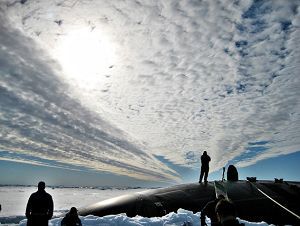The report of WWF said that the melting ice caps would result in sea-level rise which would cause up to 28 trillion dollars in damage in the main port cities of the world by 2050. “If the temperature rises between 0.5 and 2 degrees (Celsius) between now and 2050, it’s possible that the sea-level would progress by half a meter bringing huge financial damage,” Ulrike Saul, in charge of climate and energy for WWF Switzerland. The report said that such a rise in the sea-level would cause up to 28 trillion dollars in damage in the world’s 136 biggest port cities. Saul warned: "If the current climate protection policies do not change, it is more probable that we will register a rise of 2 degrees in 2050.” The northeast coast of the United States could see a rise in sea-level 15 centimeters higher than the world average, the study said. Another environmental organization “Clean Air-Cool Planet” found the melting acceleration of Gree nland and Antarctica ice sheet would result in a rise in sea-level at least 1 meter by the end of this century, which was several times higher 18 to 59 cm predicted by the United Nations Intergovernmental Panel on Climate Change (IPCC ) in 2007. Another report released by University of Texas also noted that the East Antarctica ice started to melt faster from 2006, which could cause sea-level to rise sooner than anticipated.
nland and Antarctica ice sheet would result in a rise in sea-level at least 1 meter by the end of this century, which was several times higher 18 to 59 cm predicted by the United Nations Intergovernmental Panel on Climate Change (IPCC ) in 2007. Another report released by University of Texas also noted that the East Antarctica ice started to melt faster from 2006, which could cause sea-level to rise sooner than anticipated.
The researchers previously thought that the East Antarctic ice sheet was not much influenced by the global warming. But In the study published in Nature's Geoscience journal, that they used satellites to detect the change of the gravity of the East Antarctic between April 2002 and January 2009 and found East Antarctica has been losing ice mass at an average rate of 5 to 109 gigatonnes per year. However, it started to melt faster from 2006. “Especially in the long coastal regions (in Wilkes Land and Victoria Land) that appear to start seeing a large amount of ice loss in East Antarctica since 2006.But if it is losing mass, as our data indicate, it may be an indication the state of East Antarctica has changed, ice loss there can have a large impact on global sea-level rise in the future.”, said Jianli Chen at the university's center for space research. The whole Antarctic region could be losing ice at a rate of 113-267 gigatonnes a year, with 106-158 gigatonnes coming from West Antarctica, the researchers estimate. The researcher fear that the global warming will result in the faster melting of West Antarctica. If this ice sheet totally melts, global sea-lever will rise by about 5 meters. (This article from Zaobao.com)


